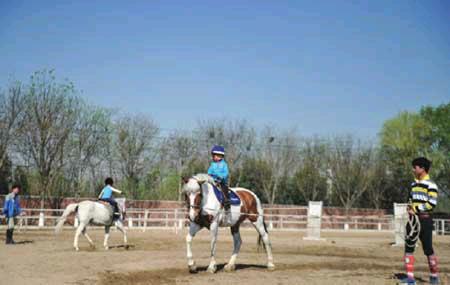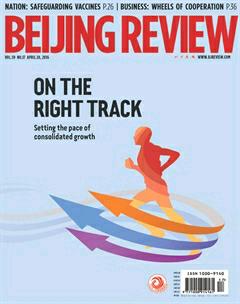Going With the Wind
2016-05-04ByWeiYao
By+Wei+Yao
It is morning and 34-year-old Beijing resident Lin Yan, dressed in professional equestrian attire, is on her horse. At the Guofa Equestrian Club training ground near Beijing Capital International Airport, she adeptly adjusts her posture in accordance with the pace of her horse.
Every Saturday morning, Lin drives for nearly one hour from her home in downtown Beijing for the riding lesson. Upon her arrival at the training ground, she is joined by a dozen or so other people, mostly young women and children.
Getting accepted
Equestrianism, once a pastime for the wealthy, has entered the life of ordinary people, especially in metropolises like Beijing. The tuition of 200-300 yuan ($31.25-46.88) per hour is now within the reach of many families.
Different from 10 or more years ago, now, many people in China can tell the difference between leisure rides in the grassland of Inner Mongolia and riding in an equestrian club. They come to the club to improve their horsemanship.
Several years ago, Lin rode horses along the Shisanling Reservoir in Beijings northern suburb. The locals leased the horses to visitors, teaching them basic horse whispering, and then let them enjoy themselves. Visitors learned little about the temperament of the horses and how to rein them.
Lin started to learn riding in the club from the beginning of this year. She paid 6,800 yuan ($1,063) for 30 hours of riding classes.
After her lessons in the equestrian club, Lin learned that leisure riding is different from the equestrianism taught in the club. She has discovered more about the traits of various horses and how to communicate with them.
The Guofa Equestrian Club has more than 1,500 members, of whom 60 percent are children and youths 3 to 28 years old. About 70 percent are female. Most of them are amateurs.
A mere 3-year-old already looks quite professional in the saddle. His father told Beijing Review that the child started to learn riding from 2 years plus because he likes animals, especially horses. The family learned about the club from a friend and then enrolled him.
“Now he can sit straight on horseback, which is a significant improvement from the beginning,” the father said, observing his son carefully. “After learning to ride, he has become braver.”
Equestrianism was introduced in China more than two decades ago. Now more and more people are becoming interested.
The Guofa Equestrian Club, set up in 1996, is one of the oldest clubs of its kind in China. Zhou Zhen, the clubs manager, told Beijing Review that at first, it was mostly a leisure and recreational venue where Beijing residents rode for fun at the weekend.
In the past decade, the club has taken on a more professional tack. Zhou said,“Around 2006, the industry became more standardized and equestrianism got popular. Many novice riders including children began to ride.” As equestrian enthusiasts get more and more familiar with foreign equestrian culture, the industry has moved closer to international standards.
Today the club owns 90 horses, including some imported steeds. The horses are trained both for training and racing. The club employs 16 coaches, who are all trained equestrians—some having competed in professional races.
Members of the club can become certified equestrians after training. Every year, the club hosts four riding competitions organized by the Beijing Equestrian Association. The association is hosting more and more such competitions. In 2015 it hosted 44 contests.
Growing industry
In the past five to six years, equestrianism has spread rapidly in China, drawing more and more participants. The equestrian industry is very market-oriented, said Zhou.“State-run training facilities are transforming into market-oriented ones, and this has invigorated the industry, making it closer to international standards.”
Equestrian equipment is a large niche market. Though equestrian clubs usually provide riding equipment for members, most still prefer to purchase their own gear, and an average member spends about 2,000 yuan($312.5) on it, Zhou said.
Some enthusiasts also buy saddles and other paraphernalia for horses, while some families bought their own horses, mostly from Europe, he said.
The procedures for importing horses from Europe are well-established and the entire process takes only 90 days, Zhou said. Now as China has signed quarantine agreements with other countries, importing horses has become easier. Some farm owners have imported different breeds, raising them on their ranches or selling them. An average imported horse costs more than 300,000 yuan ($46,875), Zhou said.
“The equestrian industry will boost economic growth and enrich our culture,” Zhou said. He added that as a veteran in the industry, he is happy about that.
It will thrive on more investment, and on the other hand, on a popular equestrian culture, Zhou said. He sees a promising future for the sport in the young children who come to his club to learn riding.
